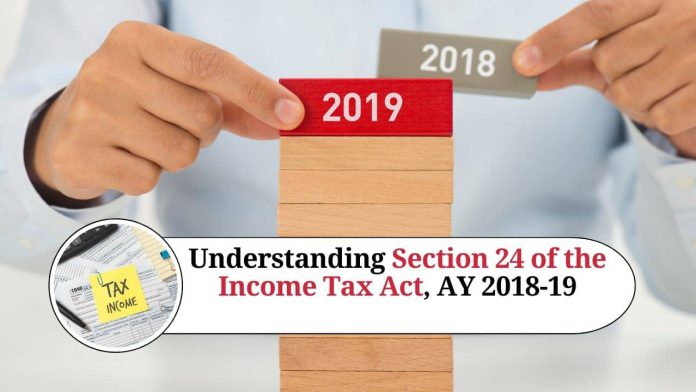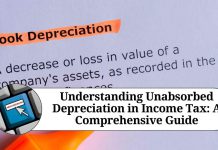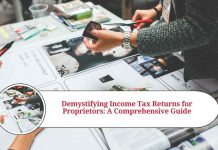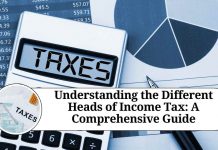Section 24 of the Income Tax Act, 1961 deals with the deductions available from income under the head “Income from House Property”. In this blog post, we will discuss Section 24 of the Income Tax Act, AY 2018-19 in detail, covering the following headings:
Introduction to Section 24:
Section 24 of the Income Tax Act, 1961 deals with the deductions available from income under the head “Income from House Property”. This section allows the taxpayer to claim a deduction from the income earned from a house property, which is chargeable to tax. The deduction is available for interest on borrowed capital and for the standard deduction.
Deduction available under Section 24:
The deduction available under Section 24 is divided into two parts:
Deduction for interest on borrowed capital: The deduction is available for the interest paid on the borrowed capital used for the acquisition, construction, repair, or renewal of a house property. The maximum deduction allowed is up to Rs. 2,00,000 per annum for self-occupied property and there is no upper limit for let-out property.
Standard deduction: A standard deduction of 30% of the net annual value (NAV) is allowed as a deduction under Section 24. The NAV is calculated by deducting municipal taxes paid from the gross annual value (GAV) of the property.
Conditions to avail deduction under Section 24:
To avail the deduction under Section 24, the following conditions must be met:
- The property should be owned and used for residential purposes only.
- The interest should be paid on borrowed capital used for the acquisition, construction, repair, or renewal of the property.
- The property should be completed and ready for possession in the year for which the deduction is being claimed.
- The interest should be paid during the financial year in which the deduction is being claimed.
Deduction in case of Self-occupied Property:
In the case of self-occupied property, the maximum deduction allowed for interest on borrowed capital is up to Rs. 2,00,000 per annum. If the interest paid on borrowed capital exceeds Rs. 2,00,000, the excess amount cannot be carried forward to the next financial year.
Deduction in case of Let-Out Property:
In the case of let-out property, there is no upper limit for the deduction for interest on borrowed capital. The entire amount of interest paid on borrowed capital can be claimed as a deduction from the income earned from the property. If the interest paid on borrowed capital exceeds the income earned from the property, the excess amount can be carried forward to the next financial year.
Impact of GST on Section 24:
With the implementation of Goods and Services Tax (GST), the tax rate on construction materials has been reduced. This has resulted in a reduction in the cost of construction, which has led to an increase in the demand for properties. This, in turn, has increased the availability of housing units, resulting in an increase in the number of individuals owning a house property. The reduction in the cost of construction has also reduced the amount of interest paid on borrowed capital, which has resulted in a reduction in the deduction available under Section 24.
Pre-construction interest:
In some cases, interest is paid on borrowed capital even before the construction of the property begins. Such interest is called pre-construction interest. The deduction for pre-construction interest is available under Section 24. However, the deduction is allowed in five equal installments, beginning from the year in which the construction of the property is completed.
Joint ownership:
In case of joint ownership of a property, each co-owner can claim a deduction for interest on borrowed capital and for the standard deduction, subject to certain conditions. If one co-owner has taken a loan for the property, only he/she can claim the deduction for interest on borrowed capital. The other co-owner can claim a deduction for the rent received from the property, if it is let-out.
Joint home loan:
In case of joint home loan, each co-borrower can claim deduction for interest paid on borrowed capital, subject to certain conditions. However, the deduction is restricted to the share of interest paid by each co-borrower. For example, if two individuals take a joint home loan, and each pays an equal share of the interest, then each can claim deduction up to Rs. 1,00,000 per annum.
Home loan for renovation:
If a taxpayer has taken a home loan for the purpose of renovation or repair of a house property, the interest paid on such loan is eligible for deduction under Section 24. However, the renovation or repair work should be completed within three years from the end of the financial year in which the loan was taken.
Reverse mortgage:
In a reverse mortgage, a homeowner pledges his/her house property to a bank or a financial institution, and receives a periodic payment from the lender. The periodic payment received is treated as a loan, and the interest paid on such loan is eligible for deduction under Section 24.
Non-resident taxpayers:
For non-resident taxpayers, the deduction under Section 24 is available only for income earned from a property located in India. The maximum deduction allowed for interest on borrowed capital is up to Rs. 2,00,000 per annum for self-occupied property and there is no upper limit for let-out property.
Conclusion:
Section 24 of the Income Tax Act, AY 2018-19 allows the taxpayer to claim a deduction from the income earned from a house property, which is chargeable to tax. The deduction is available for interest on borrowed capital and for the standard deduction. The maximum deduction allowed for interest on borrowed capital is up to Rs. 2,00,000 per annum for self-occupied property and there is no upper limit for let-out property. The taxpayer must fulfill certain conditions to claim the deduction under Section 24. It is advisable to consult a tax expert for a better understanding of the provisions of Section 24.
Read more useful content:
- section 145 of income tax act
- section 10e of income tax act
- section 9 of the income tax act
- section 94b of income tax act
- section 206aa of income tax act
Frequently Asked Questions (FAQs)
- What is Section 24 of the Income Tax Act, AY 2018-19?
Section 24 of the Income Tax Act, AY 2018-19 provides deductions for interest on borrowed capital and standard deduction for income earned from house property.
2. What is the maximum deduction allowed for interest on borrowed capital under Section 24?
The maximum deduction allowed for interest on borrowed capital under Section 24 is up to Rs. 2,00,000 per annum for self-occupied property and there is no upper limit for let-out property.
3. Is the deduction for interest on borrowed capital available for pre-construction interest?
Yes, the deduction for interest on borrowed capital is available for pre-construction interest. However, the deduction is allowed in five equal installments, beginning from the year in which the construction of the property is completed.
4. Can each co-owner claim a deduction for interest on borrowed capital and standard deduction in case of joint ownership of a property?
Yes, each co-owner can claim a deduction for interest on borrowed capital and standard deduction in case of joint ownership of a property, subject to certain conditions.
5. Is the deduction for interest on borrowed capital available for a home loan taken for renovation or repair of a house property?
Yes, the deduction for interest on borrowed capital is available for a home loan taken for renovation or repair of a house property. However, the renovation or repair work should be completed within three years from the end of the financial year in which the loan was taken.
6. What is the maximum deduction allowed for standard deduction under Section 24?
The maximum deduction allowed for standard deduction under Section 24 is 30% of the net annual value of the property.
7. Can non-resident taxpayers claim deduction under Section 24 for income earned from a property located outside India?
No, the deduction under Section 24 is available only for income earned from a property located in India for non-resident taxpayers.
8. Can a taxpayer claim deduction under Section 24 for a property that is not let-out or self-occupied?
No, deduction under Section 24 is available only for a property that is let-out or self-occupied.
9. Can the interest paid on a reverse mortgage be claimed as a deduction under Section 24?
Yes, the interest paid on a reverse mortgage is eligible for deduction under Section 24.
10. Is there any provision for carry forward of loss under Section 24?
No, there is no provision for carry forward of loss under Section 24. However, the loss can be set off against income from other heads in the same financial year.




















